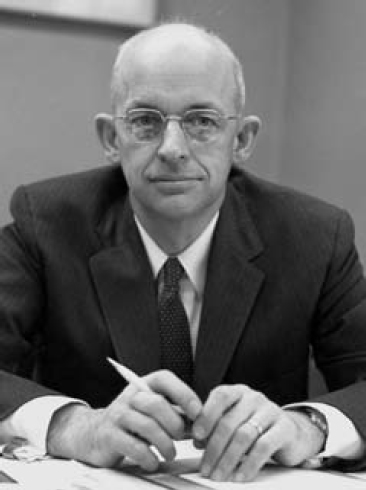
1913–2004
Elected in 1967
“For aircraft design and development.”
BY JOHN D. WARNER
GEORGE SWIFT SCHAIRER was born in Wilkinsburg, Pennsylvania, on May 19, 1913. He attended Swarthmore College and graduated in 1934 with a B.S. with highest honors in general engineering. He studied aeronautical engineering at the Massachusetts Institute of Technology (MIT) and received an M.S. in 1935. He studied airplane performance calculation methods and invented “Schairer’s Airplane Performance Slide Rule.” He learned to fly light airplanes during his college years. He had a solid foundation and interest in rotary wing and fixed wing aircraft by the time he completed his formal education.
Schairer was best known for his advocacy of swept wing aircraft and development of the B-47 and 707 that ensued. In 1945 he was part of a group of scientists who went to Germany as the war was winding down, to learn what they could about Germany’s technology. He was reviewing some wind tunnel data when he came on the swept wing innovation. At the time he was on loan from Boeing to the U.S. Army Air Corps. He wrote a letter to Boeing colleague Bob Withington about his discovery, and the rest is history. Bill Cook later said that without George the postwar history of Boeing would not have happened.
Schairer came to Boeing in 1939 after short stints at Bendix in Indiana and Consolidated Aircraft Corporation in California. Initially, he was in charge of aerodynamics and played major roles on the design teams for the B-17, B-29, Stratocruiser, B-50, C-97, 707, KC-135, B-47, B-52, and 727. He rose to vice president of research and development at Boeing and retired in 1978. After that he continued to consult for Boeing.
In 1944 and 1955 he was a full-time member of the U.S. Army Air Force Scientific Advisory Group, when he went to Germany. He was active on many committees of the National Advisory Committee for Aeronautics. He served on the Steering Panel of the U.S. Department of Defense from 1955 to 1960 and the U.S. Air Force Scientific Advisory Board from 1954 to 1958. He was a member of the President’s Science Advisory Committee Panel on Scientific and Technical Manpower from 1962 to 1964 and the Scientific Advisory Committee of the Defense Intelligence Agency from 1965 to 1970. He served on visiting committees for the University of Washington, MIT, Princeton University, and the California Institute of Technology.
Schairer was elected a fellow of the Institute of the Aeronautical Sciences in 1951 and was elected to the National Academy of Engineering in 1967, and the National Academy of Sciences in 1968.
An honorary doctor of engineering degree was awarded to Schairer from Swarthmore College in 1958. He received the Sylvanus Albert Reed Award of the Institute of Aeronautical Sciences in 1949, the Spirit of St. Louis Medal of the American Society of Mechanical Engineers in 1959, and the Daniel Guggenheim Medal of the American Institute of Aeronautics and Astronautics (AIAA)/Society of Automotive Engineers/American Society of Mechanical Engineers in 1967. He delivered the Wright Brothers Lecture of the AIAA in 1964 and the Wilbur and Orville Wright Memorial Lecture of the Royal Aeronautical Society in 1968.
George was widely known to be “an irascible son of a gun” who “was not out to make friends. He was out to get things done.” He was committed to get the best out of himself and of the people he worked with and counseled over the years.
Some of those who worked with and for him described him as a brilliant engineer, a demanding boss, a doer, and a sometimes mystifying communicator. “In meetings, we’d all listen to George and we’d have to go back to the office afterwards to figure out what the heck he said,” recalled Bob Withington. “His communication skills weren’t as good as his aeronautical thinking, but we could usually figure it out.”
Like many aerodynamicists, his recreational passion was sailing. He loved watching the wind in the sails and analyzing the behavior of the waves in the water. Having a constant fascination with all things mechanical, he enjoyed building or fixing things, including making his own replacement parts when some household object broke down and building models of his sailboat with improved keels. He also had a lifelong interest in classical music and was a great supporter of the arts, including being on the boards of the Seattle Opera, ACT Theater, and Cornish College of the Arts.
When he passed away on October 24, 2004, he was survived by his wife, four children, eight grandchildren, and 10 great-grandchildren. Joe Sutter remembered George with this statement: “He was a real technical powerhouse. His name should be on the wall at the Smithsonian. He’s really an aviation pioneer.”




